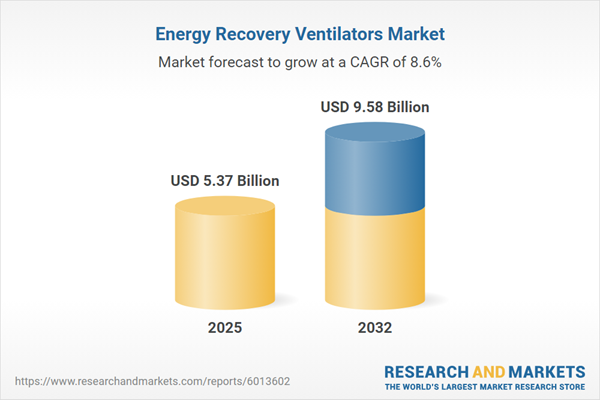Speak directly to the analyst to clarify any post sales queries you may have.
Increasing demand for efficient indoor air quality management and sustainable buildings is elevating the importance of energy recovery ventilators for organizations focused on compliance, occupant wellness, and future-proofing facilities. Senior decision-makers are leveraging these systems to drive operational improvements and align with evolving industry standards.
Market Snapshot: Energy Recovery Ventilators Market Size & Growth Outlook
The global energy recovery ventilators market is currently valued at USD 4.94 billion and is projected to reach USD 5.37 billion within the coming year, with a forecast expansion to USD 9.58 billion by 2032 and a compound annual growth rate (CAGR) of 8.61%. Growth is fueled by accelerated adoption across diverse settings, including commercial, residential, institutional, and industrial properties, as organizations strive to enhance ventilation standards, address regulatory mandates, and reinforce sustainable operations. Regulatory shifts and heightened occupant expectations continue to shape demand, establishing energy recovery ventilators as core pillars in modern building strategies.
Scope & Segmentation of the Energy Recovery Ventilators Market
- End Users: Energy recovery ventilators support commercial offices, healthcare facilities, hospitality venues, retail environments, industrial plants, educational campuses, government properties, power generation sites, and residential developments, each seeking enhanced occupant well-being and tailored performance for unique operational needs.
- Product Types: The market addresses varied ventilation requirements through heat pipe exchangers, heat wheel and rotary exchangers, and plate heat exchangers. These technologies are selected based on variables such as climate, building architecture, and specific project demands to optimize energy recovery for stakeholders.
- Distribution Channels: Direct sales, authorized distributor networks, retail partnerships, proprietary online platforms, and specialist e-commerce portals provide buyers—including HVAC professionals, facility managers, and institutional purchasers—secure access to genuine systems and dependable product support while managing procurement timelines and risks.
- Airflow Capacities: Available solutions range from compact 0–500 CFM models that suit small spaces to high-capacity options exceeding 1500 CFM. This flexibility allows deployment in both new and existing buildings, catering to projects of any scale.
- Regions: The market operates globally, with activity spanning North America, Latin America, Europe, Middle East, Africa, and Asia-Pacific. Nations such as the United States, Canada, Germany, France, China, India, and Australia influence market direction by shaping building codes, demanding advanced ventilation performance, and driving technology adoption to fit regional preferences and regulations.
- Key Market Participants: Innovation and reliability are provided by major players such as Daikin Industries, Mitsubishi Electric, Panasonic, Carrier Global, Johnson Controls, Systemair, Zehnder Group, FläktGroup, Volution Group, and Greenheck Fan Corporation, who emphasize continual product improvement and alignment with industry trends.
Energy Recovery Ventilators: Strategic Takeaways for Senior Decision-Makers
- Advanced energy recovery ventilators improve property efficiency and are suitable for both new construction and retrofit projects, providing scalable ventilation tailored to dynamic operational requirements.
- Integration with building management technologies enables real-time system oversight, fostering proactive adjustments and supporting robust compliance with health and safety regulations.
- Flexible, modular configurations allow owners and managers to adapt ventilation assets as occupant needs, health guidelines, and building functions evolve over time.
- Collaboration with established suppliers supports effective risk management during procurement and accelerates responsiveness to shifts in technology or sourcing landscape.
- Adapting system configurations ensures ongoing compliance with both local and international air quality standards, meeting long-term regulatory and business goals.
Tariff Impact & Strategic Responses
Recent changes in United States tariff structures are prompting a reassessment of sourcing strategies and supply chain management in the energy recovery ventilators sector. Organizations are favoring regional manufacturing, reinforcing partnerships with local suppliers, and embracing engineering approaches that improve value and resilience. Transparent supplier communication and focused procurement processes play a vital role in maintaining price stability and continuous system availability despite regulatory fluctuations.
Methodology & Data Sources
This report draws on extensive secondary research, input from industry engineers, operational leaders, and recognized experts. Data is validated through regulatory reviews and technology benchmarking to ensure comprehensive and accurate market analysis.
Why This Report Matters
- Enables senior leaders to make data-driven decisions on capital investments, modernization programs, and supplier selections in the energy recovery ventilators market.
- Assists organizations in managing supply chain risks, maintaining long-term operational resilience, and advancing compliance or sustainability objectives in rapidly shifting business contexts.
- Supports continuity and adaptability by providing insight into proven market strategies that address evolving compliance standards and stakeholder expectations.
Conclusion
Energy recovery ventilators are essential for organizations seeking to improve air quality and reduce operational risk. Sustained collaboration and targeted innovation position industry participants for continued progress and leadership.
Additional Product Information:
- Purchase of this report includes 1 year online access with quarterly updates.
- This report can be updated on request. Please contact our Customer Experience team using the Ask a Question widget on our website.
Table of Contents
3. Executive Summary
4. Market Overview
7. Cumulative Impact of Artificial Intelligence 2025
Companies Mentioned
The companies profiled in this Energy Recovery Ventilators market report include:- Daikin Industries, Ltd.
- Mitsubishi Electric Corporation
- Panasonic Corporation
- Carrier Global Corporation
- Johnson Controls International PLC
- Systemair AB
- Zehnder Group AG
- FläktGroup GmbH
- Volution Group PLC
- Greenheck Fan Corporation
Table Information
| Report Attribute | Details |
|---|---|
| No. of Pages | 196 |
| Published | November 2025 |
| Forecast Period | 2025 - 2032 |
| Estimated Market Value ( USD | $ 5.37 Billion |
| Forecasted Market Value ( USD | $ 9.58 Billion |
| Compound Annual Growth Rate | 8.6% |
| Regions Covered | Global |
| No. of Companies Mentioned | 11 |









